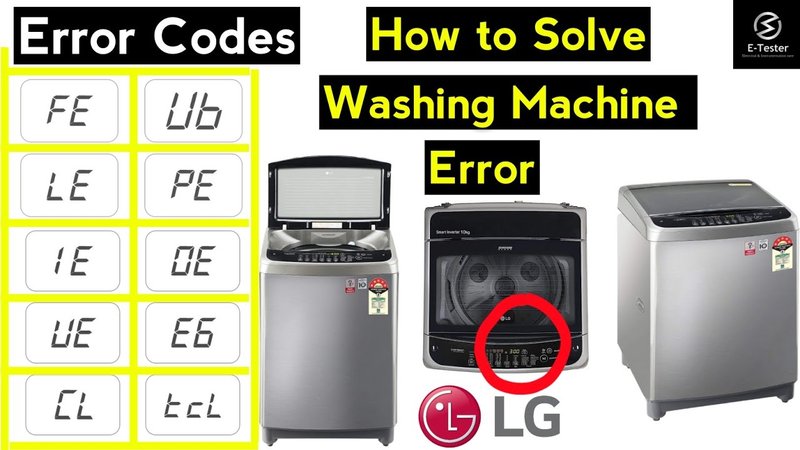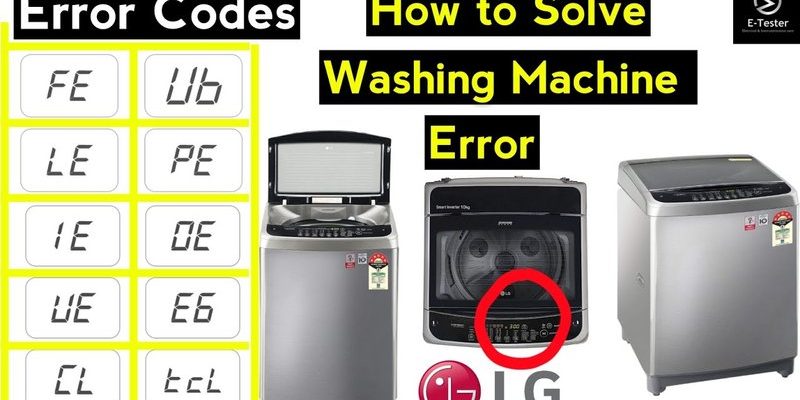
Now, you might feel a bit overwhelmed by the sight of an error code. Who wouldn’t? But, here’s the deal: not all error messages need immediate professional intervention. Some can be handled right at home. But how do you know when it’s time to roll up your sleeves or when to call in the pros? That’s exactly what we’re going to unravel here. As you read on, you’ll discover the ins and outs of what causes the E2 error and the steps you can take before deciding to bring in a technician.
Understanding the E2 Error Code
Getting to grips with the E2 error code is like unlocking a secret to smoother laundry days. This code is primarily associated with drainage issues in your LG washing machine. When the machine can’t drain properly, it flashes the E2 sign to alert you. Think of it like a traffic light turning red; it’s a signal to stop and examine the situation before proceeding.
The root of this problem often lies in a clogged or kinked drain hose. Imagine trying to drink a milkshake through a straw that’s bent or blocked with pieces of fruit—it just doesn’t work smoothly. Similarly, if the drain hose is obstructed, the water can’t flow out as it should. Additionally, there might be problems with the pump filter, which can get clogged by lint, coins, or other small objects that sneak in with your laundry.
Another potential culprit could be the drain pump itself. Just like how our hearts pump blood, the drain pump works tirelessly to expel water out of the machine. If it’s malfunctioning, water will sit stagnant in the drum. Recognizing these possible issues is the first step in deciding whether you can tackle the problem yourself or if you need to call in a technician.
When to Attempt a DIY Fix
When that E2 code pops up, your initial instinct might be to call a technician straight away. But hold on a second! There are some simple checks you can do before making that call. Start by examining the drain hose. Ensure it’s free of kinks and blockages. You might even detach it (with the machine turned off and unplugged, of course) to see if a quick rinse clears any hidden debris. Swirling water through the hose to mimic its regular function can reveal blockages much like blowing through a straw tests its flow.
Next, take a peek at the pump filter. This is usually accessible behind a small door on the front of your machine. You might find it clogged with lint or stray coins. Clearing these out can sometimes resolve the drainage issue without further fuss. It’s like removing a stone from your shoe; a small hindrance can cause significant discomfort.
If these steps seem daunting, remember that a bit of patience goes a long way. Set aside some time when you’re not rushed, focus, and give it a shot. However, if you’ve tried these steps and the E2 error persists, it might be time to consider professional help. DIY fixes are great, but knowing when to step back is crucial.
Recognizing When to Call a Technician
At times, despite your best efforts, that stubborn E2 code won’t budge. If your attempts to clear the drain hose and filter don’t resolve the issue, there may be a deeper problem afoot. Persistent drainage issues could signify a faulty drain pump or more complex electrical faults. This is akin to having a car with an engine that won’t start despite a full tank of gas—sometimes, only a mechanic can diagnose the real issue.
Calling a technician can save you time and future headaches. Professionals have the right tools and expertise to pinpoint problems accurately and provide reliable fixes. Plus, if your washing machine is still under warranty, attempting repairs yourself might void it. Therefore, enlisting a technician could actually be the more cost-effective and safer option.
In summary, while some minor issues can be resolved at home, never hesitate to call a technician if you’re in over your head. They’re there to help ensure your washing machine gets back to serving you efficiently.
Preventative Measures and Final Thoughts
No one wants to deal with error codes regularly, so what can you do to prevent them? Regular maintenance goes a long way in keeping your LG washing machine in top shape. Make it a habit to check and clean the drain filter and hose periodically. It’s a bit like brushing your teeth—not glamorous, but essential to prevent problems.
Avoid overloading your machine, as this can strain the drainage system, much like overflowing a cup causes spills. Keep an eye on your detergent use, too, since excessive suds can interfere with normal drainage. By taking these small preventative steps, you reduce the chance of seeing that pesky E2 error.
Ultimately, understanding when to call a technician boils down to recognizing when a problem is beyond your expertise. With this guide, you’re better equipped to handle the E2 error, ensuring more seamless laundry days. Remember, while a DIY spirit is great, knowing when to seek professional help is equally important. So, the next time your washing machine sends out an S.O.S., you’ll know just what to do.
